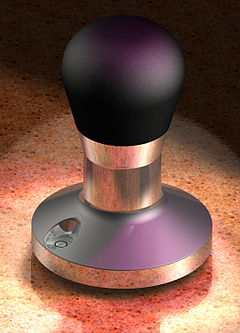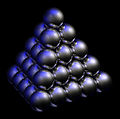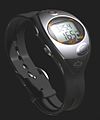| Revision as of 20:06, 11 March 2010 editGreg L (talk | contribs)Extended confirmed users, Pending changes reviewers31,897 edits →Animation tools: correct error← Previous edit | Revision as of 20:20, 11 March 2010 edit undoGreg L (talk | contribs)Extended confirmed users, Pending changes reviewers31,897 edits comparison to convey the concept in terms those skilled in the art will understandNext edit → | ||
| Line 1: | Line 1: | ||
| ] | ] | ||
| '''Cobalt''' is a ]-based ] (CAD) and ] program that runs on both ] and ] operating systems. It integrates ], freeform surfacing, feature-based solid modeling, photo-realistic rendering (see ]), and animation. It is a product of ], a ] of Vellum Investment Partners. Cobalt is history-driven with associativity and 2{{nbhyph}}D equation-driven parametrics and constraints. It offers surfacing tools, ] tools, detailing, and engineering features. Cobalt includes a library of 149,000 mechanical parts.<ref>Ashlar-Vellum: </ref> | '''Cobalt''' is a ]-based ] (CAD) and ] program that runs on both ] and ] operating systems. The program’s user interface bridges the direct-modeling way of creating objects (exemplified by programs like ]) and the highly structured, history-driven parametric way exemplified by programs like ]. It integrates ], freeform surfacing, feature-based solid modeling, photo-realistic rendering (see ]), and animation. It is a product of ], a ] of Vellum Investment Partners. Cobalt is history-driven with associativity and 2{{nbhyph}}D equation-driven parametrics and constraints. It offers surfacing tools, ] tools, detailing, and engineering features. Cobalt includes a library of 149,000 mechanical parts.<ref>Ashlar-Vellum: </ref> | ||
| Cobalt’s interface was designed in 1988 by ] <ref group="Note">Martin Newell created the ] in 1975 and later went on to work at ], where the ] (windows, mouse, menus) was invented.</ref> and Dan Fitzpatrick. The company calls it the “Vellum interface”, after their eponymous flagship product that is now part of the company’s name. The central feature of the Vellum interface is its “Drafting Assistant”, which facilitates the creation and alignment of new geometry. | Cobalt’s interface was designed in 1988 by ] <ref group="Note">Martin Newell created the ] in 1975 and later went on to work at ], where the ] (windows, mouse, menus) was invented.</ref> and Dan Fitzpatrick. The company calls it the “Vellum interface”, after their eponymous flagship product that is now part of the company’s name. The central feature of the Vellum interface is its “Drafting Assistant”, which facilitates the creation and alignment of new geometry. | ||
Revision as of 20:20, 11 March 2010

Cobalt is a parametric-based computer-aided design (CAD) and 3‑D modeling program that runs on both Macintosh and Microsoft Windows operating systems. The program’s user interface bridges the direct-modeling way of creating objects (exemplified by programs like SpaceClaim) and the highly structured, history-driven parametric way exemplified by programs like Pro/ENGINEER. It integrates wireframe, freeform surfacing, feature-based solid modeling, photo-realistic rendering (see Ray tracing), and animation. It is a product of Ashlar-Vellum, a DBA of Vellum Investment Partners. Cobalt is history-driven with associativity and 2‑D equation-driven parametrics and constraints. It offers surfacing tools, mold design tools, detailing, and engineering features. Cobalt includes a library of 149,000 mechanical parts.
Cobalt’s interface was designed in 1988 by Dr. Martin Newell and Dan Fitzpatrick. The company calls it the “Vellum interface”, after their eponymous flagship product that is now part of the company’s name. The central feature of the Vellum interface is its “Drafting Assistant”, which facilitates the creation and alignment of new geometry.
Overview
The distinguishing characteristics of Cobalt are its ease of use and the quick learning curve for new users. Cobalt inherited its 2‑D and 3‑D wireframe features from the developer’s flagship “Vellum” CAD program. With Cobalt however, wireframe geometry—which doesn’t have to be planar—can be subsequently revolved or extruded relative to any plane or along a curved path to create 3‑D solids. Beyond this, Cobalt also allows 3‑D objects may be created directly using 3‑D tools. Both modes—extruded 2‑D wireframe and directly created 3‑D solids—can be seamlessly mixed in the same drawing. Whereas history-based parametric solid modelers often require the designer to rigorously follow a logical progression while creating models and tend to require that the designer think ahead about the planned order of transmutations of the solid model, Cobalt has a more freeform, less structured way of modeling solids that the developer refers to as “Organic Workflow”.
This less-structured modeling environment, coupled with an integral ray-tracing capability, makes Cobalt particularly suitable for brainstorming and product development. Yet the program’s history-driven modeling and its equation-driven parametrics and constraints permits designers to later edit the dimensions and locations of key features in their models without the need to laboriously redesign everything; much like changing the value of a single cell in a complex spreadsheet.
Drafting Assistant
Ashlar-Vellum’s patented, 37-year-old “Drafting Assistant” is the central component of Ashlar’s “Vellum interface”.
The Drafting Assistant tracks the position of the designer’s cursor and looks for nearby geometry. It then automatically displays information alongside the cursor regarding geometric features to which the designer can snap. The designer can create new features at those snap points, or create construction lines to serve as guides. The Drafting Assistant is sensitive to the following geometric attributes:
- Centers
- Endpoints
- Intersections
- Midpoints
- Perpendicularities
- Quadrants
- Tangents
- Vertexes
Importantly, Drafting Assistant remembers the last snaps with a weighted algorithm to intuit the designer’s intentions; thus, it is easy to snap to intersections in empty 3‑D space.
In the animation at right, the designer first snaps to the X, Y, and Z-axis coordinates at the midpoint of the top edge and then snaps to the same spot on the leading edge, which has different X and Z-axis coordinates. He then moves his cursor to a point in 3‑D space where there are no geometric attributes to snap to. Although there may be 3‑D features underneath the cursor, Drafting Assistant intuits the designer’s intent and offers an intersection point comprising the Y and Z-axis coordinates of the first edge and the X-axis coordinate of the nearest edge. At this location, the designer adds a circle freehand and then specifies a diameter of 200 millimeters by typing it into the box at bottom right. Lastly, the designer uses the “Remove profile from solid” tool to cut through the block. Here again, Drafting Assistant enabled prompt definition of the depth of the cut by snapping to the back quadrant of the intersecting hole.
Note also in the animation that the Drafting Assistant provides a “Message line” at the top. This displays instructions appropriate for the selected tool, prompts the designer with what he should do next with any given tool, and reminds the designer of optional modes for those tools.
The history-driven parametric nature of Cobalt allows the designer to later edit the diameter and/or location of either circle—both of which have dependencies (holes in the block)—and the model updates accordingly.
Product family
Cobalt is the high-end member of a four-member family of products. The other three Ashlar-Vellum offerings are “Graphite”, “Argon”, and “Xenon”.
- Graphite essentially inherited the feature-set of Ashlar’s flagship product, Vellum. It offers 2‑D and 3‑D wireframe drafting and equation-driven parametrics.
- Argon is the most affordable, offering 3‑D solid modeling (but not history-based), ray tracing, and animation.
- Xenon is a less capable cousin of Cobalt, offering all of the 2‑D and 3‑D solid modeling functions of Cobalt as well as ray-trace rendering and animation. However, Xenon lacks Cobalt’s geometric and equation-driven parametrics, “Associative Assembly Tools” and the mechanical parts library, nor does it support dimensioning using geometric dimensioning and tolerancing (GD&T).
Animation tools
Cobalt features several modes for making animation, notably “Static” (where the sun and shadows move in a stationary scene), “Walk-through,” and “Fly-by”. Cobalt is also capable of six different levels of photorealistic rendering, from “Raytrace Preview Render ” through “Auto Full Render ”. Choosing less realistic modes for trial animations allows very quick rendering—even those with several hundred frames—because Cobalt fully exploits multi-core microprocessors during rendering.
The animation at right shows two industrial pushbutton switches surrounded by a virtual “photo studio” in a Cobalt model. The mirrored hemisphere enables the reader to see the back wall, floor, and ceiling lights, which all contribute to the nature of the light reflecting off the switches. Face-on images of these switches were used in the development of a touchscreen-based human–machine interface (HMI) for use in industrial manufacturing settings.
To create this animation, Cobalt prompted the designer to specify an arc for the camera to follow, a point at which the camera should point, and then it rendered the animation. A designer can specify such attributes as the angle for the camera’s field of view and can turn on settings such as perspective, which gives rendered images a vanishing point.
Whether the designer is rendering a single image or a multi-frame animation, Cobalt offers broad control of lighting, including the ability to illuminate images with sunlight wherein the date, time of day, latitude, and longitude are all user-adjustable to obtain accurate shadows.
Gallery
-
 Platinum-iridium definition of the kilogram. Used in Kilogram articles throughout the world.
Platinum-iridium definition of the kilogram. Used in Kilogram articles throughout the world.
-
 Face-centered cubic molecular crystal arrangement; one of two most-compact arrangements known.
Face-centered cubic molecular crystal arrangement; one of two most-compact arrangements known.
-
 Originally to show molecular crystal structure. The gold balls highlight the distinction to hexagonal.
Originally to show molecular crystal structure. The gold balls highlight the distinction to hexagonal.
-
 Another molecular arrangement known as “hexagonal”. Used on Close-packing of spheres.
Another molecular arrangement known as “hexagonal”. Used on Close-packing of spheres.
-
 An example of ray tracing. Used on Ray tracing (graphics).
An example of ray tracing. Used on Ray tracing (graphics).
-
 Wrist-worn heart rate monitor for Sports Instruments.
Wrist-worn heart rate monitor for Sports Instruments.
-
 Shower head concept.
Shower head concept.
-
 Sport watch for Sports Instruments.
Sport watch for Sports Instruments.
-
 Liquid measuring cup for COPCO.
Liquid measuring cup for COPCO.
-
 Geometry in solid modeling is fully described in 3‑D space; objects can be viewed from any angle.
Geometry in solid modeling is fully described in 3‑D space; objects can be viewed from any angle.
See also
- Comparison of CAD editors for architecture, engineering and construction (AEC) (comparative list of other CAD programs)
- 3D computer graphics software (with a list of other major CAD programs)
- Comparison of 3D computer graphics software
- 3D computer graphics
- 3D modeling
- Computer-aided design
- Geometric dimensioning and tolerancing
- Ray tracing
- Solid modeling
Notes
- Martin Newell created the Utah teapot in 1975 and later went on to work at Xerox PARC, where the graphical user interface (windows, mouse, menus) was invented.
References
- Ashlar-Vellum: Cobalt™ Feature List
- ^ MCADVision: “Blend of 2‑D and 3‑D Solid Modeling Speeds Design of New Heart Rate Monitor Watch”, by Luc Heiligenstein of Tres Design Group
- Ashlar-Vellum’s overview: Organic Workflow
- Patent No. 5,123,087 (fetch from USPTO), and 5,371,845 (fetch from USPTO)
- Ashlar-Vellum’s overview: The Drafting Assistant™
- Ashlar-Vellum: Product Overview (product-family comparison chart)
External links
- Ashlar-Vellum: Cobalt™ (product overview)